Distribution Management: Logistics Strategies of UPS and FedEx
VerifiedAdded on 2022/09/09
|10
|2418
|18
Report
AI Summary
This report provides a comprehensive analysis of distribution management, focusing on the critical role of logistics within supply chains. It examines the core functions of logistics, including the planning and management of goods from raw materials to the end customer, with the dual objectives of minimizing costs and ensuring timely delivery. The report investigates the logistics strategies of two major companies, United Parcel Service (UPS) and FedEx, highlighting five key value-added services: form, place, time, quantity, and possession utilities. It explores how these services create both advantages and disadvantages for companies, using functional examples from UPS and FedEx. The report also includes case studies of both companies, illustrating how they implement these strategies and the impact on their operations and customer satisfaction. The conclusion emphasizes the importance of logistics in achieving competitive advantages and the need for continuous improvement in employee skills and technology to sustain high performance.
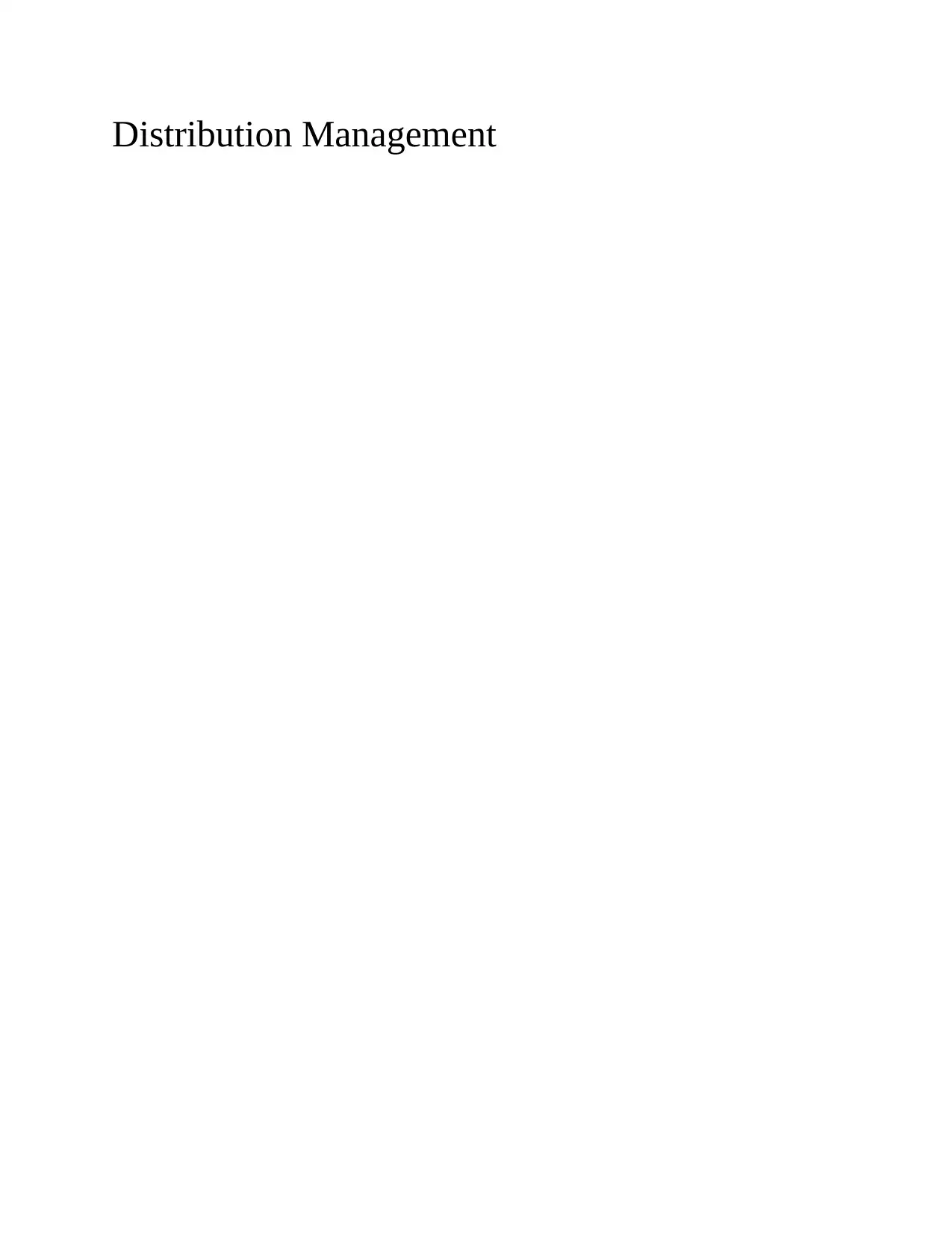
Distribution Management
Paraphrase This Document
Need a fresh take? Get an instant paraphrase of this document with our AI Paraphraser
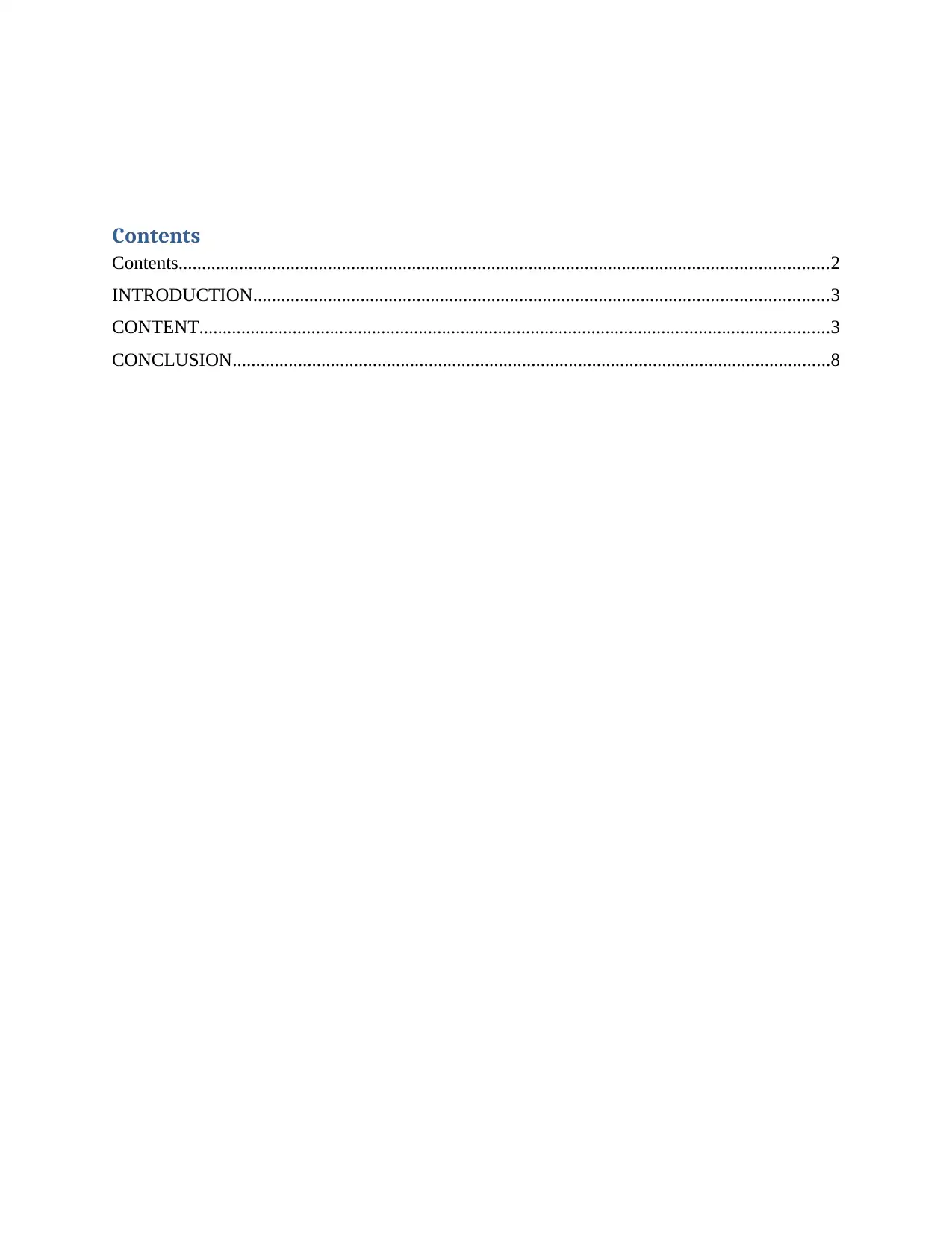
Contents
Contents...........................................................................................................................................2
INTRODUCTION...........................................................................................................................3
CONTENT.......................................................................................................................................3
CONCLUSION................................................................................................................................8
Contents...........................................................................................................................................2
INTRODUCTION...........................................................................................................................3
CONTENT.......................................................................................................................................3
CONCLUSION................................................................................................................................8
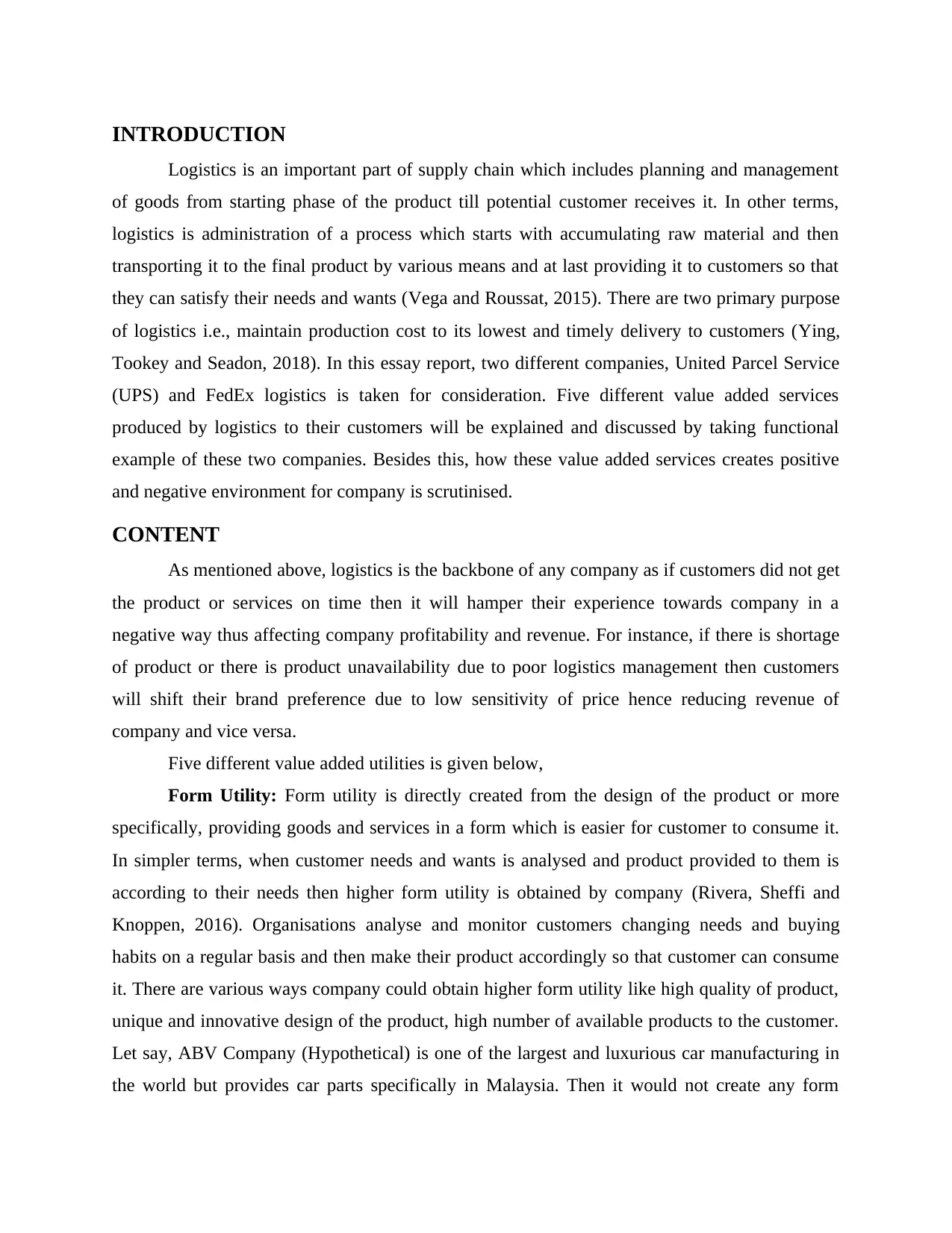
INTRODUCTION
Logistics is an important part of supply chain which includes planning and management
of goods from starting phase of the product till potential customer receives it. In other terms,
logistics is administration of a process which starts with accumulating raw material and then
transporting it to the final product by various means and at last providing it to customers so that
they can satisfy their needs and wants (Vega and Roussat, 2015). There are two primary purpose
of logistics i.e., maintain production cost to its lowest and timely delivery to customers (Ying,
Tookey and Seadon, 2018). In this essay report, two different companies, United Parcel Service
(UPS) and FedEx logistics is taken for consideration. Five different value added services
produced by logistics to their customers will be explained and discussed by taking functional
example of these two companies. Besides this, how these value added services creates positive
and negative environment for company is scrutinised.
CONTENT
As mentioned above, logistics is the backbone of any company as if customers did not get
the product or services on time then it will hamper their experience towards company in a
negative way thus affecting company profitability and revenue. For instance, if there is shortage
of product or there is product unavailability due to poor logistics management then customers
will shift their brand preference due to low sensitivity of price hence reducing revenue of
company and vice versa.
Five different value added utilities is given below,
Form Utility: Form utility is directly created from the design of the product or more
specifically, providing goods and services in a form which is easier for customer to consume it.
In simpler terms, when customer needs and wants is analysed and product provided to them is
according to their needs then higher form utility is obtained by company (Rivera, Sheffi and
Knoppen, 2016). Organisations analyse and monitor customers changing needs and buying
habits on a regular basis and then make their product accordingly so that customer can consume
it. There are various ways company could obtain higher form utility like high quality of product,
unique and innovative design of the product, high number of available products to the customer.
Let say, ABV Company (Hypothetical) is one of the largest and luxurious car manufacturing in
the world but provides car parts specifically in Malaysia. Then it would not create any form
Logistics is an important part of supply chain which includes planning and management
of goods from starting phase of the product till potential customer receives it. In other terms,
logistics is administration of a process which starts with accumulating raw material and then
transporting it to the final product by various means and at last providing it to customers so that
they can satisfy their needs and wants (Vega and Roussat, 2015). There are two primary purpose
of logistics i.e., maintain production cost to its lowest and timely delivery to customers (Ying,
Tookey and Seadon, 2018). In this essay report, two different companies, United Parcel Service
(UPS) and FedEx logistics is taken for consideration. Five different value added services
produced by logistics to their customers will be explained and discussed by taking functional
example of these two companies. Besides this, how these value added services creates positive
and negative environment for company is scrutinised.
CONTENT
As mentioned above, logistics is the backbone of any company as if customers did not get
the product or services on time then it will hamper their experience towards company in a
negative way thus affecting company profitability and revenue. For instance, if there is shortage
of product or there is product unavailability due to poor logistics management then customers
will shift their brand preference due to low sensitivity of price hence reducing revenue of
company and vice versa.
Five different value added utilities is given below,
Form Utility: Form utility is directly created from the design of the product or more
specifically, providing goods and services in a form which is easier for customer to consume it.
In simpler terms, when customer needs and wants is analysed and product provided to them is
according to their needs then higher form utility is obtained by company (Rivera, Sheffi and
Knoppen, 2016). Organisations analyse and monitor customers changing needs and buying
habits on a regular basis and then make their product accordingly so that customer can consume
it. There are various ways company could obtain higher form utility like high quality of product,
unique and innovative design of the product, high number of available products to the customer.
Let say, ABV Company (Hypothetical) is one of the largest and luxurious car manufacturing in
the world but provides car parts specifically in Malaysia. Then it would not create any form
⊘ This is a preview!⊘
Do you want full access?
Subscribe today to unlock all pages.

Trusted by 1+ million students worldwide
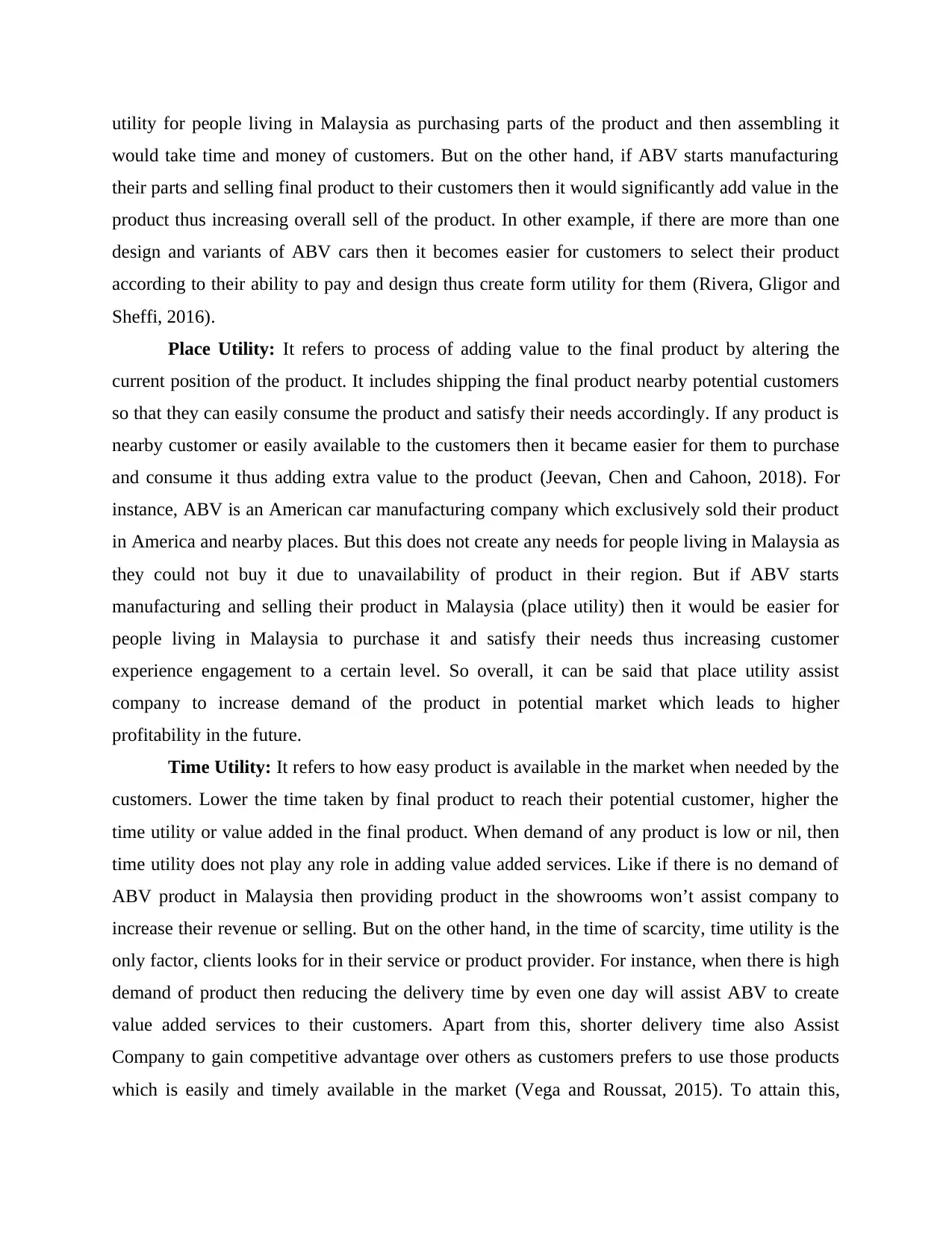
utility for people living in Malaysia as purchasing parts of the product and then assembling it
would take time and money of customers. But on the other hand, if ABV starts manufacturing
their parts and selling final product to their customers then it would significantly add value in the
product thus increasing overall sell of the product. In other example, if there are more than one
design and variants of ABV cars then it becomes easier for customers to select their product
according to their ability to pay and design thus create form utility for them (Rivera, Gligor and
Sheffi, 2016).
Place Utility: It refers to process of adding value to the final product by altering the
current position of the product. It includes shipping the final product nearby potential customers
so that they can easily consume the product and satisfy their needs accordingly. If any product is
nearby customer or easily available to the customers then it became easier for them to purchase
and consume it thus adding extra value to the product (Jeevan, Chen and Cahoon, 2018). For
instance, ABV is an American car manufacturing company which exclusively sold their product
in America and nearby places. But this does not create any needs for people living in Malaysia as
they could not buy it due to unavailability of product in their region. But if ABV starts
manufacturing and selling their product in Malaysia (place utility) then it would be easier for
people living in Malaysia to purchase it and satisfy their needs thus increasing customer
experience engagement to a certain level. So overall, it can be said that place utility assist
company to increase demand of the product in potential market which leads to higher
profitability in the future.
Time Utility: It refers to how easy product is available in the market when needed by the
customers. Lower the time taken by final product to reach their potential customer, higher the
time utility or value added in the final product. When demand of any product is low or nil, then
time utility does not play any role in adding value added services. Like if there is no demand of
ABV product in Malaysia then providing product in the showrooms won’t assist company to
increase their revenue or selling. But on the other hand, in the time of scarcity, time utility is the
only factor, clients looks for in their service or product provider. For instance, when there is high
demand of product then reducing the delivery time by even one day will assist ABV to create
value added services to their customers. Apart from this, shorter delivery time also Assist
Company to gain competitive advantage over others as customers prefers to use those products
which is easily and timely available in the market (Vega and Roussat, 2015). To attain this,
would take time and money of customers. But on the other hand, if ABV starts manufacturing
their parts and selling final product to their customers then it would significantly add value in the
product thus increasing overall sell of the product. In other example, if there are more than one
design and variants of ABV cars then it becomes easier for customers to select their product
according to their ability to pay and design thus create form utility for them (Rivera, Gligor and
Sheffi, 2016).
Place Utility: It refers to process of adding value to the final product by altering the
current position of the product. It includes shipping the final product nearby potential customers
so that they can easily consume the product and satisfy their needs accordingly. If any product is
nearby customer or easily available to the customers then it became easier for them to purchase
and consume it thus adding extra value to the product (Jeevan, Chen and Cahoon, 2018). For
instance, ABV is an American car manufacturing company which exclusively sold their product
in America and nearby places. But this does not create any needs for people living in Malaysia as
they could not buy it due to unavailability of product in their region. But if ABV starts
manufacturing and selling their product in Malaysia (place utility) then it would be easier for
people living in Malaysia to purchase it and satisfy their needs thus increasing customer
experience engagement to a certain level. So overall, it can be said that place utility assist
company to increase demand of the product in potential market which leads to higher
profitability in the future.
Time Utility: It refers to how easy product is available in the market when needed by the
customers. Lower the time taken by final product to reach their potential customer, higher the
time utility or value added in the final product. When demand of any product is low or nil, then
time utility does not play any role in adding value added services. Like if there is no demand of
ABV product in Malaysia then providing product in the showrooms won’t assist company to
increase their revenue or selling. But on the other hand, in the time of scarcity, time utility is the
only factor, clients looks for in their service or product provider. For instance, when there is high
demand of product then reducing the delivery time by even one day will assist ABV to create
value added services to their customers. Apart from this, shorter delivery time also Assist
Company to gain competitive advantage over others as customers prefers to use those products
which is easily and timely available in the market (Vega and Roussat, 2015). To attain this,
Paraphrase This Document
Need a fresh take? Get an instant paraphrase of this document with our AI Paraphraser
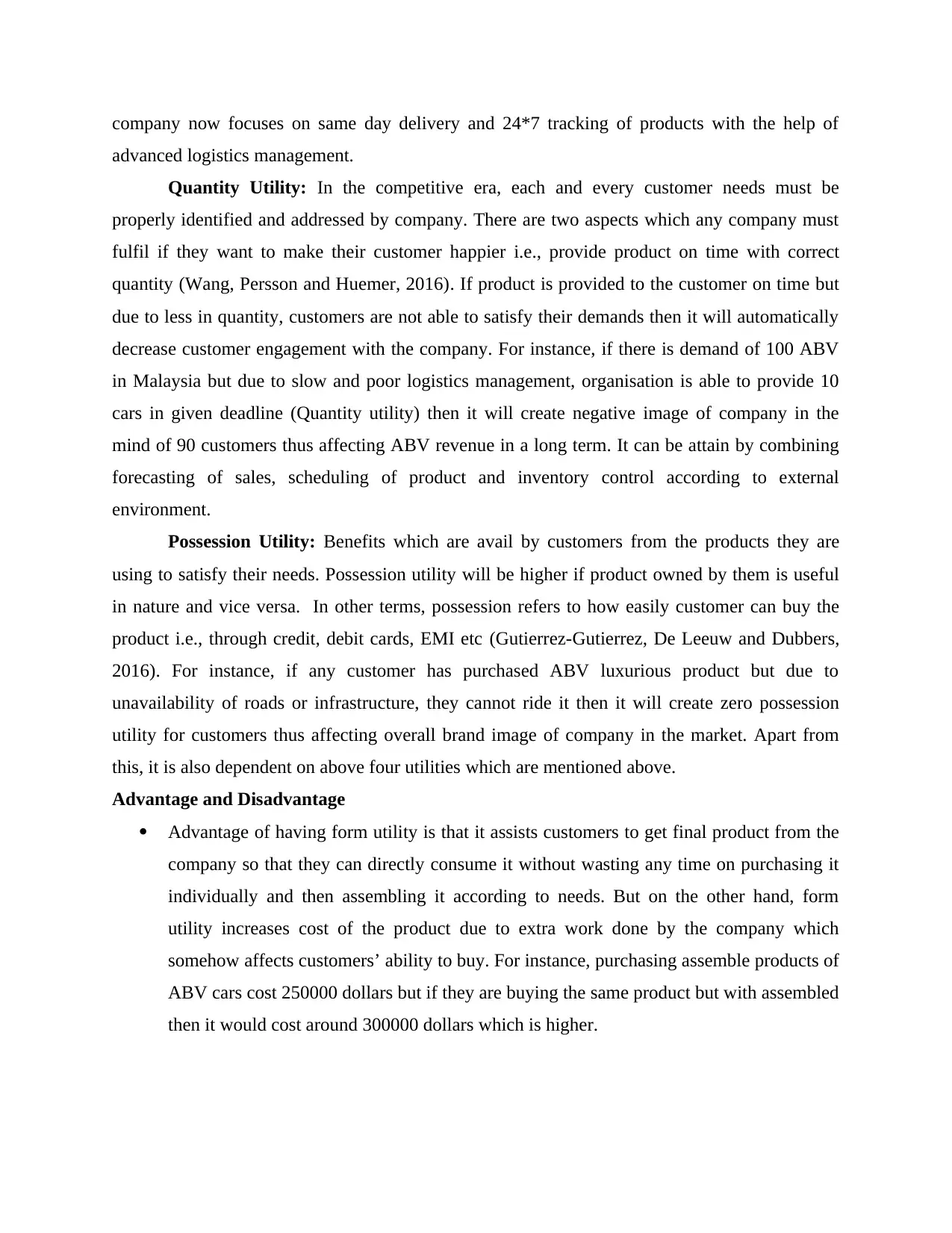
company now focuses on same day delivery and 24*7 tracking of products with the help of
advanced logistics management.
Quantity Utility: In the competitive era, each and every customer needs must be
properly identified and addressed by company. There are two aspects which any company must
fulfil if they want to make their customer happier i.e., provide product on time with correct
quantity (Wang, Persson and Huemer, 2016). If product is provided to the customer on time but
due to less in quantity, customers are not able to satisfy their demands then it will automatically
decrease customer engagement with the company. For instance, if there is demand of 100 ABV
in Malaysia but due to slow and poor logistics management, organisation is able to provide 10
cars in given deadline (Quantity utility) then it will create negative image of company in the
mind of 90 customers thus affecting ABV revenue in a long term. It can be attain by combining
forecasting of sales, scheduling of product and inventory control according to external
environment.
Possession Utility: Benefits which are avail by customers from the products they are
using to satisfy their needs. Possession utility will be higher if product owned by them is useful
in nature and vice versa. In other terms, possession refers to how easily customer can buy the
product i.e., through credit, debit cards, EMI etc (Gutierrez-Gutierrez, De Leeuw and Dubbers,
2016). For instance, if any customer has purchased ABV luxurious product but due to
unavailability of roads or infrastructure, they cannot ride it then it will create zero possession
utility for customers thus affecting overall brand image of company in the market. Apart from
this, it is also dependent on above four utilities which are mentioned above.
Advantage and Disadvantage
Advantage of having form utility is that it assists customers to get final product from the
company so that they can directly consume it without wasting any time on purchasing it
individually and then assembling it according to needs. But on the other hand, form
utility increases cost of the product due to extra work done by the company which
somehow affects customers’ ability to buy. For instance, purchasing assemble products of
ABV cars cost 250000 dollars but if they are buying the same product but with assembled
then it would cost around 300000 dollars which is higher.
advanced logistics management.
Quantity Utility: In the competitive era, each and every customer needs must be
properly identified and addressed by company. There are two aspects which any company must
fulfil if they want to make their customer happier i.e., provide product on time with correct
quantity (Wang, Persson and Huemer, 2016). If product is provided to the customer on time but
due to less in quantity, customers are not able to satisfy their demands then it will automatically
decrease customer engagement with the company. For instance, if there is demand of 100 ABV
in Malaysia but due to slow and poor logistics management, organisation is able to provide 10
cars in given deadline (Quantity utility) then it will create negative image of company in the
mind of 90 customers thus affecting ABV revenue in a long term. It can be attain by combining
forecasting of sales, scheduling of product and inventory control according to external
environment.
Possession Utility: Benefits which are avail by customers from the products they are
using to satisfy their needs. Possession utility will be higher if product owned by them is useful
in nature and vice versa. In other terms, possession refers to how easily customer can buy the
product i.e., through credit, debit cards, EMI etc (Gutierrez-Gutierrez, De Leeuw and Dubbers,
2016). For instance, if any customer has purchased ABV luxurious product but due to
unavailability of roads or infrastructure, they cannot ride it then it will create zero possession
utility for customers thus affecting overall brand image of company in the market. Apart from
this, it is also dependent on above four utilities which are mentioned above.
Advantage and Disadvantage
Advantage of having form utility is that it assists customers to get final product from the
company so that they can directly consume it without wasting any time on purchasing it
individually and then assembling it according to needs. But on the other hand, form
utility increases cost of the product due to extra work done by the company which
somehow affects customers’ ability to buy. For instance, purchasing assemble products of
ABV cars cost 250000 dollars but if they are buying the same product but with assembled
then it would cost around 300000 dollars which is higher.
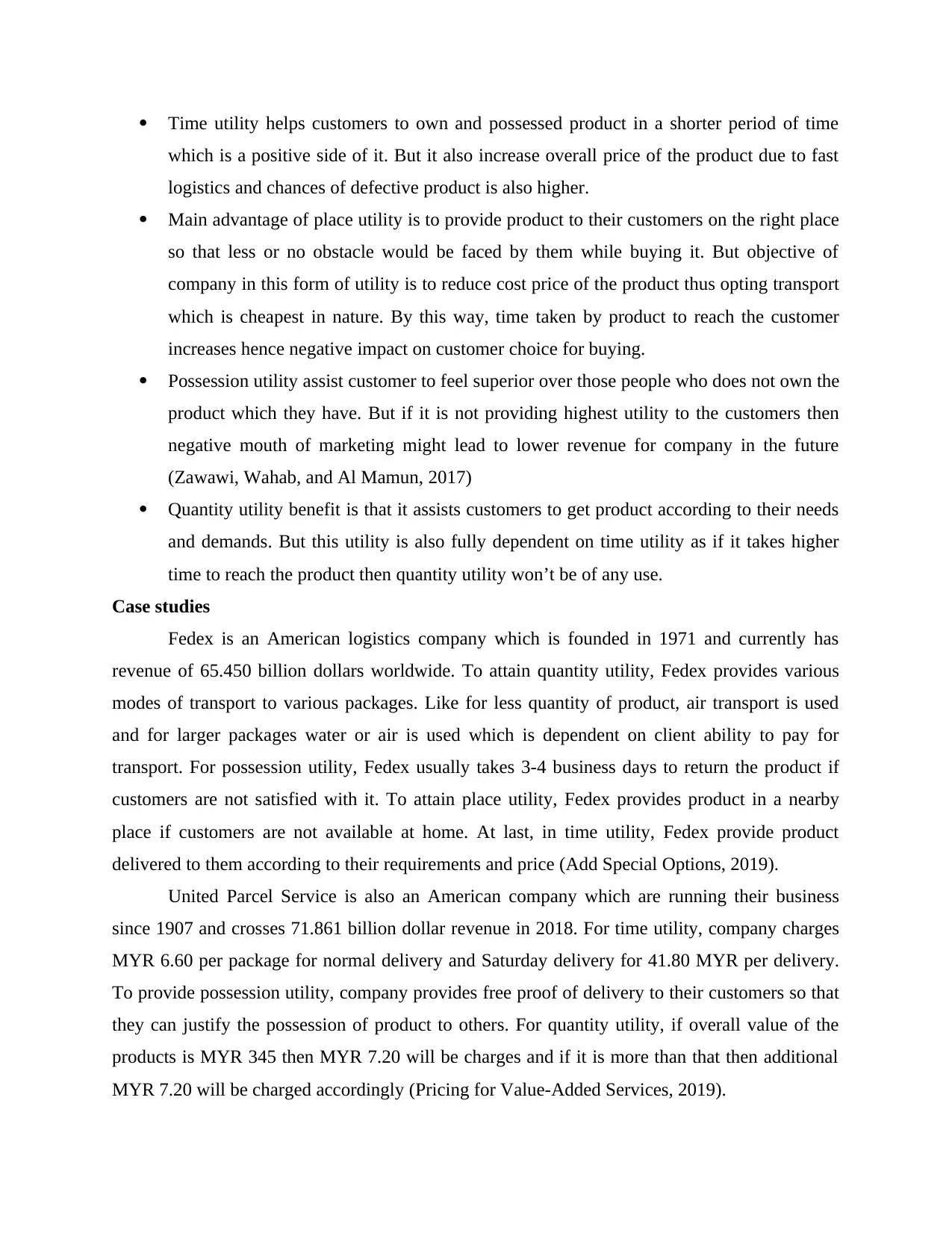
Time utility helps customers to own and possessed product in a shorter period of time
which is a positive side of it. But it also increase overall price of the product due to fast
logistics and chances of defective product is also higher.
Main advantage of place utility is to provide product to their customers on the right place
so that less or no obstacle would be faced by them while buying it. But objective of
company in this form of utility is to reduce cost price of the product thus opting transport
which is cheapest in nature. By this way, time taken by product to reach the customer
increases hence negative impact on customer choice for buying.
Possession utility assist customer to feel superior over those people who does not own the
product which they have. But if it is not providing highest utility to the customers then
negative mouth of marketing might lead to lower revenue for company in the future
(Zawawi, Wahab, and Al Mamun, 2017)
Quantity utility benefit is that it assists customers to get product according to their needs
and demands. But this utility is also fully dependent on time utility as if it takes higher
time to reach the product then quantity utility won’t be of any use.
Case studies
Fedex is an American logistics company which is founded in 1971 and currently has
revenue of 65.450 billion dollars worldwide. To attain quantity utility, Fedex provides various
modes of transport to various packages. Like for less quantity of product, air transport is used
and for larger packages water or air is used which is dependent on client ability to pay for
transport. For possession utility, Fedex usually takes 3-4 business days to return the product if
customers are not satisfied with it. To attain place utility, Fedex provides product in a nearby
place if customers are not available at home. At last, in time utility, Fedex provide product
delivered to them according to their requirements and price (Add Special Options, 2019).
United Parcel Service is also an American company which are running their business
since 1907 and crosses 71.861 billion dollar revenue in 2018. For time utility, company charges
MYR 6.60 per package for normal delivery and Saturday delivery for 41.80 MYR per delivery.
To provide possession utility, company provides free proof of delivery to their customers so that
they can justify the possession of product to others. For quantity utility, if overall value of the
products is MYR 345 then MYR 7.20 will be charges and if it is more than that then additional
MYR 7.20 will be charged accordingly (Pricing for Value-Added Services, 2019).
which is a positive side of it. But it also increase overall price of the product due to fast
logistics and chances of defective product is also higher.
Main advantage of place utility is to provide product to their customers on the right place
so that less or no obstacle would be faced by them while buying it. But objective of
company in this form of utility is to reduce cost price of the product thus opting transport
which is cheapest in nature. By this way, time taken by product to reach the customer
increases hence negative impact on customer choice for buying.
Possession utility assist customer to feel superior over those people who does not own the
product which they have. But if it is not providing highest utility to the customers then
negative mouth of marketing might lead to lower revenue for company in the future
(Zawawi, Wahab, and Al Mamun, 2017)
Quantity utility benefit is that it assists customers to get product according to their needs
and demands. But this utility is also fully dependent on time utility as if it takes higher
time to reach the product then quantity utility won’t be of any use.
Case studies
Fedex is an American logistics company which is founded in 1971 and currently has
revenue of 65.450 billion dollars worldwide. To attain quantity utility, Fedex provides various
modes of transport to various packages. Like for less quantity of product, air transport is used
and for larger packages water or air is used which is dependent on client ability to pay for
transport. For possession utility, Fedex usually takes 3-4 business days to return the product if
customers are not satisfied with it. To attain place utility, Fedex provides product in a nearby
place if customers are not available at home. At last, in time utility, Fedex provide product
delivered to them according to their requirements and price (Add Special Options, 2019).
United Parcel Service is also an American company which are running their business
since 1907 and crosses 71.861 billion dollar revenue in 2018. For time utility, company charges
MYR 6.60 per package for normal delivery and Saturday delivery for 41.80 MYR per delivery.
To provide possession utility, company provides free proof of delivery to their customers so that
they can justify the possession of product to others. For quantity utility, if overall value of the
products is MYR 345 then MYR 7.20 will be charges and if it is more than that then additional
MYR 7.20 will be charged accordingly (Pricing for Value-Added Services, 2019).
⊘ This is a preview!⊘
Do you want full access?
Subscribe today to unlock all pages.

Trusted by 1+ million students worldwide
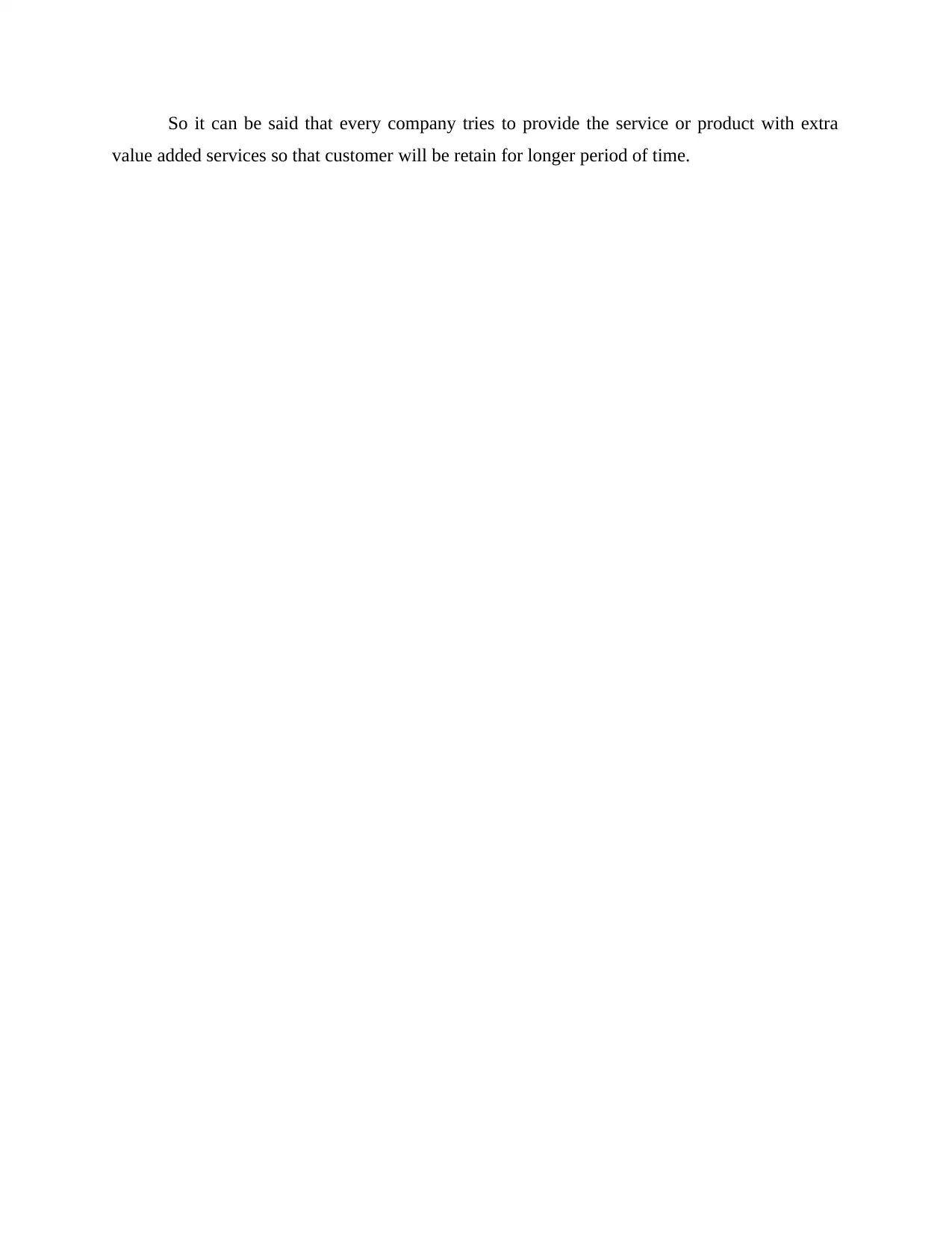
So it can be said that every company tries to provide the service or product with extra
value added services so that customer will be retain for longer period of time.
value added services so that customer will be retain for longer period of time.
Paraphrase This Document
Need a fresh take? Get an instant paraphrase of this document with our AI Paraphraser
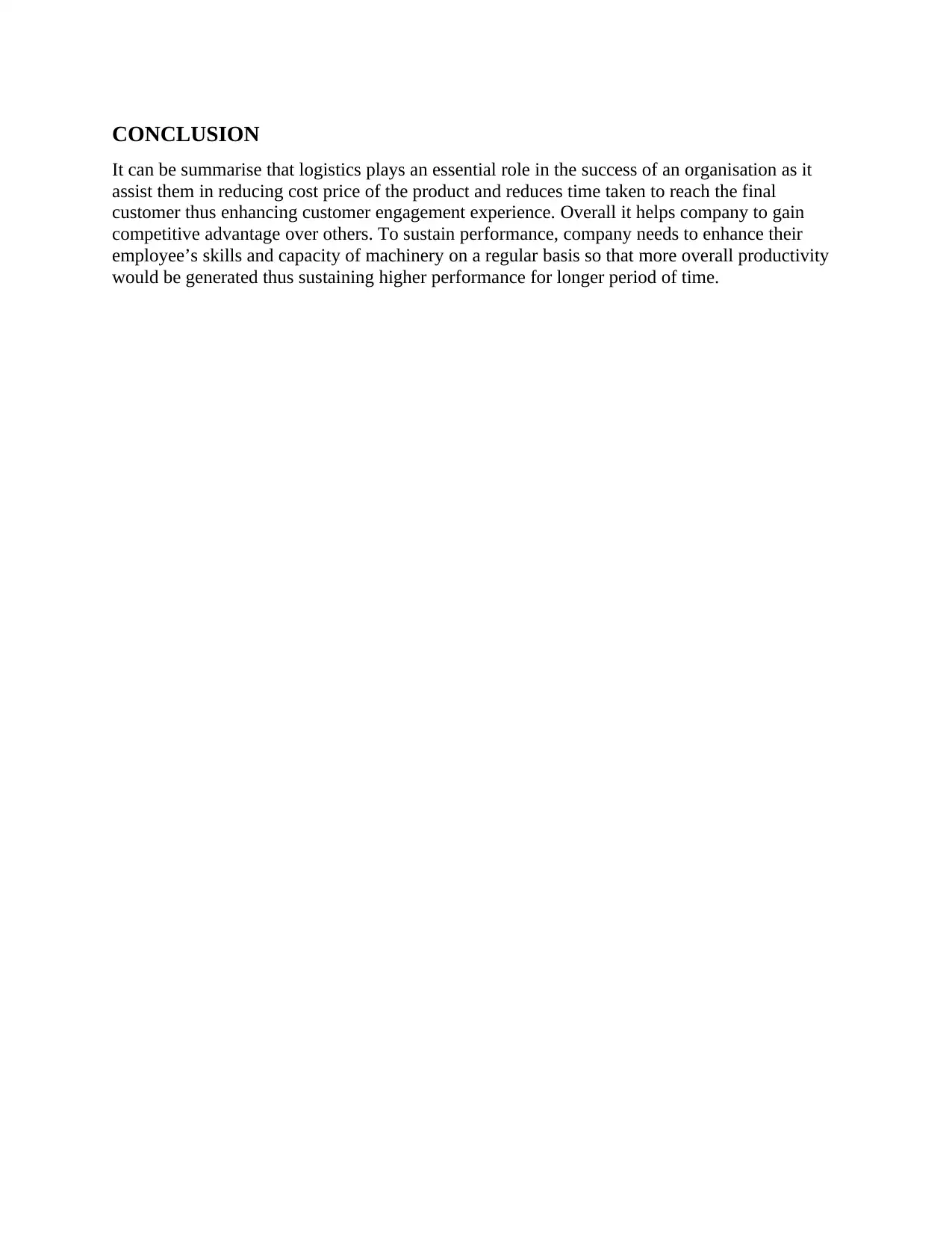
CONCLUSION
It can be summarise that logistics plays an essential role in the success of an organisation as it
assist them in reducing cost price of the product and reduces time taken to reach the final
customer thus enhancing customer engagement experience. Overall it helps company to gain
competitive advantage over others. To sustain performance, company needs to enhance their
employee’s skills and capacity of machinery on a regular basis so that more overall productivity
would be generated thus sustaining higher performance for longer period of time.
It can be summarise that logistics plays an essential role in the success of an organisation as it
assist them in reducing cost price of the product and reduces time taken to reach the final
customer thus enhancing customer engagement experience. Overall it helps company to gain
competitive advantage over others. To sustain performance, company needs to enhance their
employee’s skills and capacity of machinery on a regular basis so that more overall productivity
would be generated thus sustaining higher performance for longer period of time.
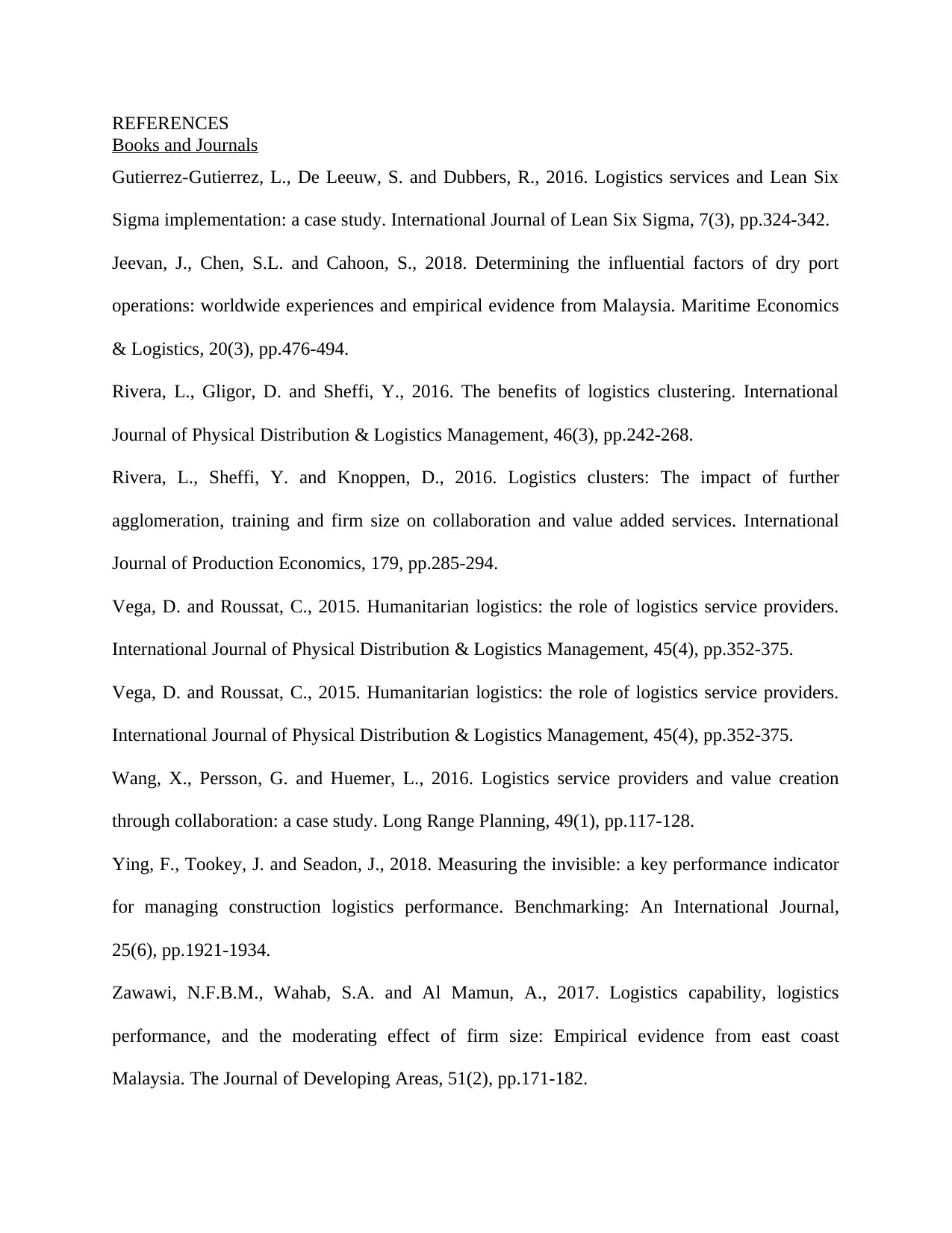
REFERENCES
Books and Journals
Gutierrez-Gutierrez, L., De Leeuw, S. and Dubbers, R., 2016. Logistics services and Lean Six
Sigma implementation: a case study. International Journal of Lean Six Sigma, 7(3), pp.324-342.
Jeevan, J., Chen, S.L. and Cahoon, S., 2018. Determining the influential factors of dry port
operations: worldwide experiences and empirical evidence from Malaysia. Maritime Economics
& Logistics, 20(3), pp.476-494.
Rivera, L., Gligor, D. and Sheffi, Y., 2016. The benefits of logistics clustering. International
Journal of Physical Distribution & Logistics Management, 46(3), pp.242-268.
Rivera, L., Sheffi, Y. and Knoppen, D., 2016. Logistics clusters: The impact of further
agglomeration, training and firm size on collaboration and value added services. International
Journal of Production Economics, 179, pp.285-294.
Vega, D. and Roussat, C., 2015. Humanitarian logistics: the role of logistics service providers.
International Journal of Physical Distribution & Logistics Management, 45(4), pp.352-375.
Vega, D. and Roussat, C., 2015. Humanitarian logistics: the role of logistics service providers.
International Journal of Physical Distribution & Logistics Management, 45(4), pp.352-375.
Wang, X., Persson, G. and Huemer, L., 2016. Logistics service providers and value creation
through collaboration: a case study. Long Range Planning, 49(1), pp.117-128.
Ying, F., Tookey, J. and Seadon, J., 2018. Measuring the invisible: a key performance indicator
for managing construction logistics performance. Benchmarking: An International Journal,
25(6), pp.1921-1934.
Zawawi, N.F.B.M., Wahab, S.A. and Al Mamun, A., 2017. Logistics capability, logistics
performance, and the moderating effect of firm size: Empirical evidence from east coast
Malaysia. The Journal of Developing Areas, 51(2), pp.171-182.
Books and Journals
Gutierrez-Gutierrez, L., De Leeuw, S. and Dubbers, R., 2016. Logistics services and Lean Six
Sigma implementation: a case study. International Journal of Lean Six Sigma, 7(3), pp.324-342.
Jeevan, J., Chen, S.L. and Cahoon, S., 2018. Determining the influential factors of dry port
operations: worldwide experiences and empirical evidence from Malaysia. Maritime Economics
& Logistics, 20(3), pp.476-494.
Rivera, L., Gligor, D. and Sheffi, Y., 2016. The benefits of logistics clustering. International
Journal of Physical Distribution & Logistics Management, 46(3), pp.242-268.
Rivera, L., Sheffi, Y. and Knoppen, D., 2016. Logistics clusters: The impact of further
agglomeration, training and firm size on collaboration and value added services. International
Journal of Production Economics, 179, pp.285-294.
Vega, D. and Roussat, C., 2015. Humanitarian logistics: the role of logistics service providers.
International Journal of Physical Distribution & Logistics Management, 45(4), pp.352-375.
Vega, D. and Roussat, C., 2015. Humanitarian logistics: the role of logistics service providers.
International Journal of Physical Distribution & Logistics Management, 45(4), pp.352-375.
Wang, X., Persson, G. and Huemer, L., 2016. Logistics service providers and value creation
through collaboration: a case study. Long Range Planning, 49(1), pp.117-128.
Ying, F., Tookey, J. and Seadon, J., 2018. Measuring the invisible: a key performance indicator
for managing construction logistics performance. Benchmarking: An International Journal,
25(6), pp.1921-1934.
Zawawi, N.F.B.M., Wahab, S.A. and Al Mamun, A., 2017. Logistics capability, logistics
performance, and the moderating effect of firm size: Empirical evidence from east coast
Malaysia. The Journal of Developing Areas, 51(2), pp.171-182.
⊘ This is a preview!⊘
Do you want full access?
Subscribe today to unlock all pages.

Trusted by 1+ million students worldwide
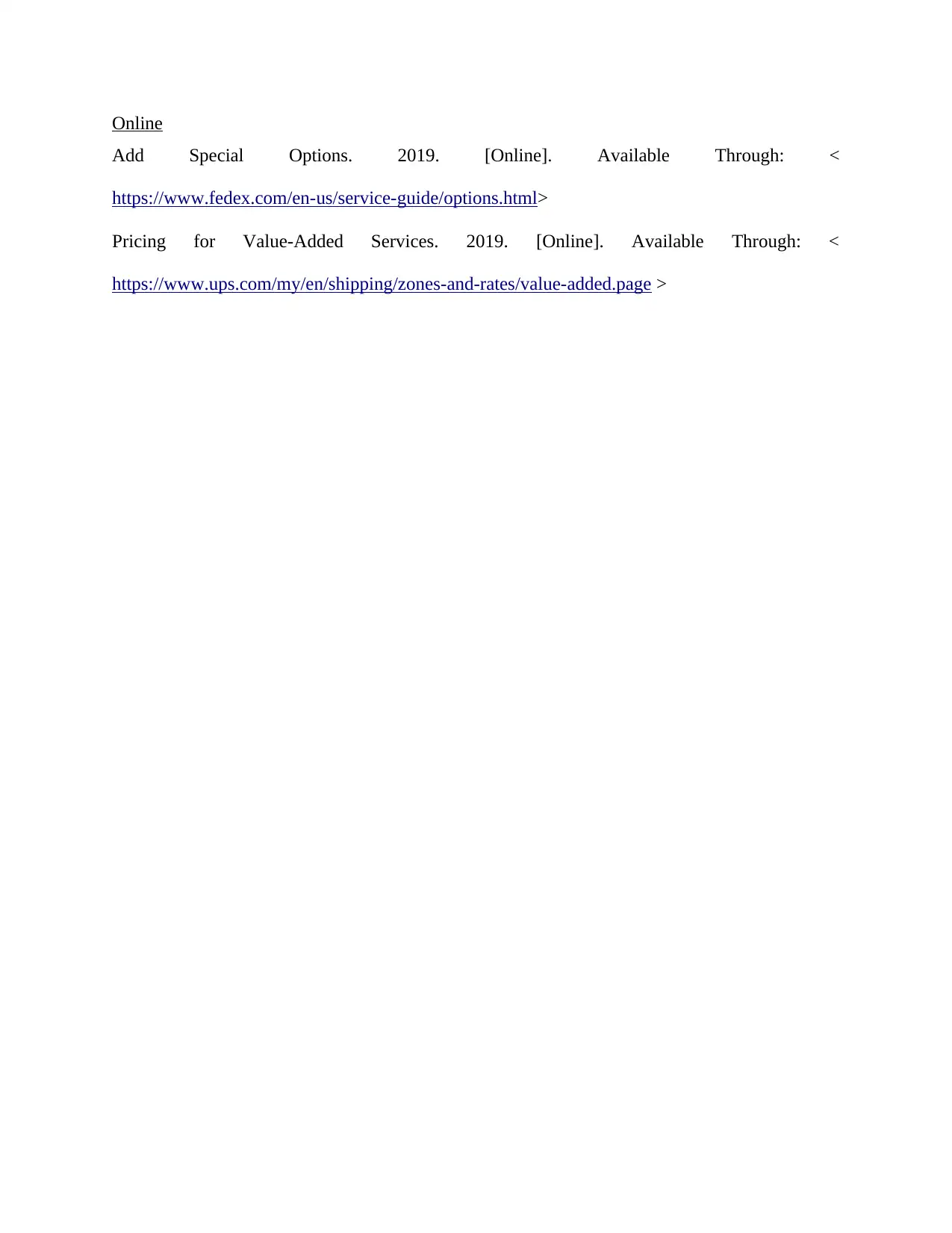
Online
Add Special Options. 2019. [Online]. Available Through: <
https://www.fedex.com/en-us/service-guide/options.html>
Pricing for Value-Added Services. 2019. [Online]. Available Through: <
https://www.ups.com/my/en/shipping/zones-and-rates/value-added.page >
Add Special Options. 2019. [Online]. Available Through: <
https://www.fedex.com/en-us/service-guide/options.html>
Pricing for Value-Added Services. 2019. [Online]. Available Through: <
https://www.ups.com/my/en/shipping/zones-and-rates/value-added.page >
1 out of 10
Related Documents
Your All-in-One AI-Powered Toolkit for Academic Success.
+13062052269
info@desklib.com
Available 24*7 on WhatsApp / Email
![[object Object]](/_next/static/media/star-bottom.7253800d.svg)
Unlock your academic potential
Copyright © 2020–2025 A2Z Services. All Rights Reserved. Developed and managed by ZUCOL.





